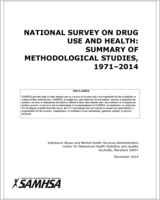


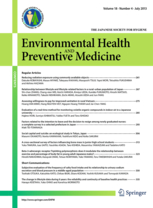


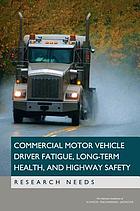 Commercial motor vehicle driver fatigue, long-term health, and highway safety : research needs
by
There are approximately 4,000 fatalities in crashes involving trucks and buses in the United States each year. Though estimates are wide-ranging, possibly 10 to 20 percent of these crashes might have involved fatigued drivers. The stresses associated with their particular jobs (irregular schedules, etc.) and the lifestyle that many truck and bus drivers lead, puts them at substantial risk for insufficient sleep and for developing short- and long-term health problems. Commercial Motor Vehicle Driver Fatigue, Long-Term Health and Highway Safety assesses the state of knowledge about the relationship of such factors as hours of driving, hours on duty, and periods of rest to the fatigue experienced by truck and bus drivers while driving and the implications for the safe operation of their vehicles. This report evaluates the relationship of these factors to drivers' health over the longer term, and identifies improvements in data and research methods that can lead to better understanding in both areas.
Commercial motor vehicle driver fatigue, long-term health, and highway safety : research needs
by
There are approximately 4,000 fatalities in crashes involving trucks and buses in the United States each year. Though estimates are wide-ranging, possibly 10 to 20 percent of these crashes might have involved fatigued drivers. The stresses associated with their particular jobs (irregular schedules, etc.) and the lifestyle that many truck and bus drivers lead, puts them at substantial risk for insufficient sleep and for developing short- and long-term health problems. Commercial Motor Vehicle Driver Fatigue, Long-Term Health and Highway Safety assesses the state of knowledge about the relationship of such factors as hours of driving, hours on duty, and periods of rest to the fatigue experienced by truck and bus drivers while driving and the implications for the safe operation of their vehicles. This report evaluates the relationship of these factors to drivers' health over the longer term, and identifies improvements in data and research methods that can lead to better understanding in both areas.
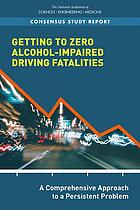 Getting to Zero Alcohol-Impaired Driving Fatalities
by
Alcohol-impaired driving is an important health and social issue as it remains a major risk to Americans' health today, surpassing deaths per year of certain cancers, HIV/AIDS, and drownings, among others, and contributing to long-term disabilities from head and spinal injuries. Progress has been made over the past decades towards reducing these trends, but that progress has been incremental and has stagnated more recently. Getting to Zero Alcohol-Impaired Driving Fatalities examines which interventions (programs, systems, and policies) are most promising to prevent injuries and death from alcohol-impaired driving, the barriers to action and approaches to overcome them, and which interventions need to be changed or adopted. This report makes broad-reaching recommendations that will serve as a blueprint for the nation to accelerate the progress in reducing alcohol-impaired driving fatalities.
Getting to Zero Alcohol-Impaired Driving Fatalities
by
Alcohol-impaired driving is an important health and social issue as it remains a major risk to Americans' health today, surpassing deaths per year of certain cancers, HIV/AIDS, and drownings, among others, and contributing to long-term disabilities from head and spinal injuries. Progress has been made over the past decades towards reducing these trends, but that progress has been incremental and has stagnated more recently. Getting to Zero Alcohol-Impaired Driving Fatalities examines which interventions (programs, systems, and policies) are most promising to prevent injuries and death from alcohol-impaired driving, the barriers to action and approaches to overcome them, and which interventions need to be changed or adopted. This report makes broad-reaching recommendations that will serve as a blueprint for the nation to accelerate the progress in reducing alcohol-impaired driving fatalities.



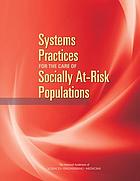 Systems Practices for the Care of Socially at-Risk Populations
by
The Centers for Medicare & Medicaid Services (CMS) have been moving from volume-based, fee-for-service payment to value-based payment (VBP), which aims to improve health care quality, health outcomes, and patient care experiences, while also controlling costs. Since the passage of the Patient Protection and Affordable Care Act of 2010, CMS has implemented a variety of VBP strategies, including incentive programs and risk-based alternative payment models. Early evidence from these programs raised concerns about potential unintended consequences for health equity. Specifically, emerging evidence suggests that providers disproportionately serving patients with social risk factors for poor health outcomes (e.g., individuals with low socioeconomic position, racial and ethnic minorities, gender and sexual minorities, socially isolated persons, and individuals residing in disadvantaged neighborhoods) may be more likely to fare poorly on quality rankings and to receive financial penalties, and less likely to receive financial rewards. The drivers of these disparities are poorly understood, and differences in interpretation have led to divergent concerns about the potential effect of VBP on health equity. Some suggest that underlying differences in patient characteristics that are out of the control of providers lead to differences in health outcomes. At the same time, others are concerned that differences in outcomes between providers serving socially at-risk populations and providers serving the general population reflect disparities in the provision of health care. Systems Practices for the Care of Socially At-Risk Populations seeks to better distinguish the drivers of variations in performance among providers disproportionately serving socially at-risk populations and identifies methods to account for social risk factors in Medicare payment programs. This report identifies best practices of high-performing hospitals, health plans, and other providers that serve disproportionately higher shares of socioeconomically disadvantaged populations and compares those best practices of low-performing providers serving similar patient populations. It is the second in a series of five brief reports that aim to inform the Office of the Assistant Secretary of Planning and Evaluation (ASPE) analyses that account for social risk factors in Medicare payment programs mandated through the Improving Medicare Post-Acute Care Transformation (IMPACT) Act.
Systems Practices for the Care of Socially at-Risk Populations
by
The Centers for Medicare & Medicaid Services (CMS) have been moving from volume-based, fee-for-service payment to value-based payment (VBP), which aims to improve health care quality, health outcomes, and patient care experiences, while also controlling costs. Since the passage of the Patient Protection and Affordable Care Act of 2010, CMS has implemented a variety of VBP strategies, including incentive programs and risk-based alternative payment models. Early evidence from these programs raised concerns about potential unintended consequences for health equity. Specifically, emerging evidence suggests that providers disproportionately serving patients with social risk factors for poor health outcomes (e.g., individuals with low socioeconomic position, racial and ethnic minorities, gender and sexual minorities, socially isolated persons, and individuals residing in disadvantaged neighborhoods) may be more likely to fare poorly on quality rankings and to receive financial penalties, and less likely to receive financial rewards. The drivers of these disparities are poorly understood, and differences in interpretation have led to divergent concerns about the potential effect of VBP on health equity. Some suggest that underlying differences in patient characteristics that are out of the control of providers lead to differences in health outcomes. At the same time, others are concerned that differences in outcomes between providers serving socially at-risk populations and providers serving the general population reflect disparities in the provision of health care. Systems Practices for the Care of Socially At-Risk Populations seeks to better distinguish the drivers of variations in performance among providers disproportionately serving socially at-risk populations and identifies methods to account for social risk factors in Medicare payment programs. This report identifies best practices of high-performing hospitals, health plans, and other providers that serve disproportionately higher shares of socioeconomically disadvantaged populations and compares those best practices of low-performing providers serving similar patient populations. It is the second in a series of five brief reports that aim to inform the Office of the Assistant Secretary of Planning and Evaluation (ASPE) analyses that account for social risk factors in Medicare payment programs mandated through the Improving Medicare Post-Acute Care Transformation (IMPACT) Act.

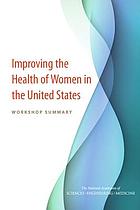 Improving the Health of Women in the United States
by
The environment for women's health has changed over the last 25 years. Increased use of automobiles can lead to health risks from lack of physical activity. There has also been an increase in access to and consumption of unhealthy food. Other changes in the past 2 to 3 decades include the significant increase in the number of women who are heads of households and responsible for all aspects of a household and family. Many women now are also having children later in life, which poses interesting issues for both biology and sociology. The growing stress faced by women and the effect of stress on health and illness are issues that need a more comprehensive examination, as do issues of mental health and mental illness, which have been more common and thus increasingly prominent issues for U.S. women. In September 2015, the National Academies of Sciences, Engineering, and Medicine convened a workshop to shed light on important determinants, consequences, effects, and issues attending the relative disadvantage of women in the United States in comparison with women in other economically advanced nations. This report summarizes the presentations and discussions from the workshop.
Improving the Health of Women in the United States
by
The environment for women's health has changed over the last 25 years. Increased use of automobiles can lead to health risks from lack of physical activity. There has also been an increase in access to and consumption of unhealthy food. Other changes in the past 2 to 3 decades include the significant increase in the number of women who are heads of households and responsible for all aspects of a household and family. Many women now are also having children later in life, which poses interesting issues for both biology and sociology. The growing stress faced by women and the effect of stress on health and illness are issues that need a more comprehensive examination, as do issues of mental health and mental illness, which have been more common and thus increasingly prominent issues for U.S. women. In September 2015, the National Academies of Sciences, Engineering, and Medicine convened a workshop to shed light on important determinants, consequences, effects, and issues attending the relative disadvantage of women in the United States in comparison with women in other economically advanced nations. This report summarizes the presentations and discussions from the workshop.

 The promise of adolescence : realizing opportunity for all youth
by
The promise of adolescence : realizing opportunity for all youth
by
 Vibrant and healthy kids : aligning science, practice, and policy to advance health equity
by
All children deserve the opportunity to meet their full health potential and lead a fulfilling life. Our nation's future depends on it. Yet, there are millions of children in the United States who are not afforded this opportunity today. While spending a record amount of money on health care services, the United States has the worst infant mortality rate among 19 similar wealthy nations, and the U.S. maternal mortality rate in 2018 was our highest since 2000. Although the United States is one of the richest nations in the world, in 2015 more than 9.6 million children lived in families with annual incomes below the poverty line (based on the Supplemental Poverty Measure), with approximately 2.1 million living in deep poverty. The highest rates of poverty were found among Hispanic, African American, and American Indian/Alaska Native families. This is deeply concerning because poverty during pregnancy and childhood is directly tied to poor health and developmental outcomes. Our nation's health disparities, of which there are many, are directly linked to what happens in early children and prenatally (and even earlier). For all children to lead fulfilling lives, we need to first achieve health equity as a nation, and to do so, we must focus on the youngest, and most vulnerable, in our nation. We also need to look beyond health care for solutions; while health care is necessary to improve health outcomes, fixing health care alone will not address health inequities.
Vibrant and healthy kids : aligning science, practice, and policy to advance health equity
by
All children deserve the opportunity to meet their full health potential and lead a fulfilling life. Our nation's future depends on it. Yet, there are millions of children in the United States who are not afforded this opportunity today. While spending a record amount of money on health care services, the United States has the worst infant mortality rate among 19 similar wealthy nations, and the U.S. maternal mortality rate in 2018 was our highest since 2000. Although the United States is one of the richest nations in the world, in 2015 more than 9.6 million children lived in families with annual incomes below the poverty line (based on the Supplemental Poverty Measure), with approximately 2.1 million living in deep poverty. The highest rates of poverty were found among Hispanic, African American, and American Indian/Alaska Native families. This is deeply concerning because poverty during pregnancy and childhood is directly tied to poor health and developmental outcomes. Our nation's health disparities, of which there are many, are directly linked to what happens in early children and prenatally (and even earlier). For all children to lead fulfilling lives, we need to first achieve health equity as a nation, and to do so, we must focus on the youngest, and most vulnerable, in our nation. We also need to look beyond health care for solutions; while health care is necessary to improve health outcomes, fixing health care alone will not address health inequities.



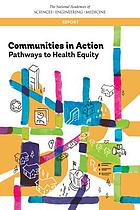 Communities in Action
by
In the United States, some populations suffer from far greater disparities in health than others. Those disparities are caused not only by fundamental differences in health status across segments of the population, but also because of inequities in factors that impact health status, so-called determinants of health. Only part of an individual's health status depends on his or her behavior and choice; community-wide problems like poverty, unemployment, poor education, inadequate housing, poor public transportation, interpersonal violence, and decaying neighborhoods also contribute to health inequities, as well as the historic and ongoing interplay of structures, policies, and norms that shape lives. When these factors are not optimal in a community, it does not mean they are intractable: such inequities can be mitigated by social policies that can shape health in powerful ways. Communities in Action: Pathways to Health Equity seeks to delineate the causes of and the solutions to health inequities in the United States. This report focuses on what communities can do to promote health equity, what actions are needed by the many and varied stakeholders that are part of communities or support them, as well as the root causes and structural barriers that need to be overcome.
Communities in Action
by
In the United States, some populations suffer from far greater disparities in health than others. Those disparities are caused not only by fundamental differences in health status across segments of the population, but also because of inequities in factors that impact health status, so-called determinants of health. Only part of an individual's health status depends on his or her behavior and choice; community-wide problems like poverty, unemployment, poor education, inadequate housing, poor public transportation, interpersonal violence, and decaying neighborhoods also contribute to health inequities, as well as the historic and ongoing interplay of structures, policies, and norms that shape lives. When these factors are not optimal in a community, it does not mean they are intractable: such inequities can be mitigated by social policies that can shape health in powerful ways. Communities in Action: Pathways to Health Equity seeks to delineate the causes of and the solutions to health inequities in the United States. This report focuses on what communities can do to promote health equity, what actions are needed by the many and varied stakeholders that are part of communities or support them, as well as the root causes and structural barriers that need to be overcome.
 Improving Quality of Care in Low- and Middle-Income Countries
by
Quality of care is a priority for U.S. Agency for International Development (USAID). The agency's missions abroad and their host country partners work in quality improvement, but a lack of evidence about the best ways to facilitate such improvements has constrained their informed selection of interventions. Six different methods - accreditation, COPE, improvement collaborative, standards-based management and recognitions (SBM-R), supervision, and clinical in-service training - currently make up the majority of this investment for USAID missions. As their already substantial investment in quality grows, there is demand for more scientific evidence on how to reliably improve quality of care in poor countries. USAID missions, and many other organizations spending on quality improvement, would welcome more information about how different strategies work to improve quality, when and where certain tools are most effective, and the best ways to measure success and shortcomings. To gain a better understanding of the evidence supporting different quality improvement tools and clarity on how they would help advance the global quality improvement agenda, the Institute of Medicine convened a 2-day workshop in January 2015. The workshop's goal was to illuminate these different methods, discussing their pros and cons. This workshop summary is a description of the presentations and discussions.
Improving Quality of Care in Low- and Middle-Income Countries
by
Quality of care is a priority for U.S. Agency for International Development (USAID). The agency's missions abroad and their host country partners work in quality improvement, but a lack of evidence about the best ways to facilitate such improvements has constrained their informed selection of interventions. Six different methods - accreditation, COPE, improvement collaborative, standards-based management and recognitions (SBM-R), supervision, and clinical in-service training - currently make up the majority of this investment for USAID missions. As their already substantial investment in quality grows, there is demand for more scientific evidence on how to reliably improve quality of care in poor countries. USAID missions, and many other organizations spending on quality improvement, would welcome more information about how different strategies work to improve quality, when and where certain tools are most effective, and the best ways to measure success and shortcomings. To gain a better understanding of the evidence supporting different quality improvement tools and clarity on how they would help advance the global quality improvement agenda, the Institute of Medicine convened a 2-day workshop in January 2015. The workshop's goal was to illuminate these different methods, discussing their pros and cons. This workshop summary is a description of the presentations and discussions.
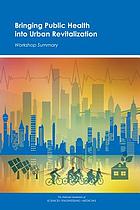 Bringing Public Health into Urban Revitalization
by
A particularly valuable opportunity to improve public health arises when an urban area is being redesigned and rebuilt following some type of serious disruption, whether it is caused by a sudden physical event, such as a hurricane or earthquake, or steady economic and social decline that may have occurred over decades. On November 10, 2014, the Institute of Medicine's Roundtable on Environmental Health Sciences, Research, and Medicine held a workshop concerning the ways in which the urban environment, conceived broadly from factors such as air quality and walkability to factors such as access to fresh foods and social support systems, can affect health. Participants explored the various opportunities to reimagine the built environment in a city and to increase the role of health promotion and protection during the process of urban revitalization. Bringing Public Health into Urban Revitalization summarizes the presentations and discussions from this workshop.
Bringing Public Health into Urban Revitalization
by
A particularly valuable opportunity to improve public health arises when an urban area is being redesigned and rebuilt following some type of serious disruption, whether it is caused by a sudden physical event, such as a hurricane or earthquake, or steady economic and social decline that may have occurred over decades. On November 10, 2014, the Institute of Medicine's Roundtable on Environmental Health Sciences, Research, and Medicine held a workshop concerning the ways in which the urban environment, conceived broadly from factors such as air quality and walkability to factors such as access to fresh foods and social support systems, can affect health. Participants explored the various opportunities to reimagine the built environment in a city and to increase the role of health promotion and protection during the process of urban revitalization. Bringing Public Health into Urban Revitalization summarizes the presentations and discussions from this workshop.
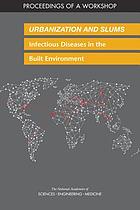 Urbanization and slums : infectious diseases in the built environment ; proceedings of a workshop
by
"The urban built environment is a prime setting for microbial transmission, because just as cities serve as hubs for migration and international travel, components of the urban built environment serve as hubs that drive the transmission of infectious disease pathogens. The risk of infectious diseases for many people living in slums is further compounded by their poverty and their surrounding physical and social environment, which is often overcrowded, is prone to physical hazards, and lacks adequate or secure housing and basic infrastructure, including water, sanitation, or hygiene services. To examine the role of the urban built environment in the emergence and reemergence of infectious diseases that affect human health, the National Academies of Sciences, Engineering, and Medicine planned a public workshop. This publication summarizes the presentations and discussions from the workshop"--Publisher's description
Urbanization and slums : infectious diseases in the built environment ; proceedings of a workshop
by
"The urban built environment is a prime setting for microbial transmission, because just as cities serve as hubs for migration and international travel, components of the urban built environment serve as hubs that drive the transmission of infectious disease pathogens. The risk of infectious diseases for many people living in slums is further compounded by their poverty and their surrounding physical and social environment, which is often overcrowded, is prone to physical hazards, and lacks adequate or secure housing and basic infrastructure, including water, sanitation, or hygiene services. To examine the role of the urban built environment in the emergence and reemergence of infectious diseases that affect human health, the National Academies of Sciences, Engineering, and Medicine planned a public workshop. This publication summarizes the presentations and discussions from the workshop"--Publisher's description

 LGBTQ cultures : what health care professionals need to know about sexual and gender diversity
by
Drawn from real-world experience and current research, the fully updated LGBTQ Cultures, 3rd Edition paves the way for healthcare professionals to provide well-informed, culturally sensitive healthcare to lesbian, gay, bisexual, transgender, and queer (LGBTQ) patients. vital guide fills the LGBTQ awareness gaps, including replacing myths and stereotypes with facts, and measuring the effects of social stigma on health. Vital for all nursing specialties, this is the seminal guide to actively providing appropriate, culturally sensitive care to persons of all sexual orientations and gender identities. -- Provided by publisher.
LGBTQ cultures : what health care professionals need to know about sexual and gender diversity
by
Drawn from real-world experience and current research, the fully updated LGBTQ Cultures, 3rd Edition paves the way for healthcare professionals to provide well-informed, culturally sensitive healthcare to lesbian, gay, bisexual, transgender, and queer (LGBTQ) patients. vital guide fills the LGBTQ awareness gaps, including replacing myths and stereotypes with facts, and measuring the effects of social stigma on health. Vital for all nursing specialties, this is the seminal guide to actively providing appropriate, culturally sensitive care to persons of all sexual orientations and gender identities. -- Provided by publisher.
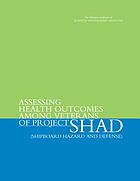 Assessing Health Outcomes among Veterans of Project SHAD (Shipboard Hazard and Defense)
by
Between 1963 and 1969, the U.S. military carried out a series of tests, termed Project SHAD (Shipboard Hazard and Defense), to evaluate the vulnerabilities of U.S. Navy ships to chemical and biological warfare agents. These tests involved use of active chemical and biological agents, stimulants, tracers, and decontaminants. Approximately 5,900 military personnel, primarily from the Navy and Marine Corps, are reported to have been included in Project SHAD testing. In the 1990s some veterans who participated in the SHAD tests expressed concerns to the Department of Veterans Affairs (VA) that they were experiencing health problems that might be the result of exposures in the testing. These concerns led to a 2002 request from VA to the Institute of Medicine (IOM) to carry out an epidemiological study of the health of SHAD veterans and a comparison population of veterans who had served on similar ships or in similar units during the same time period. In response to continuing concerns, Congress in 2010 requested an additional IOM study. This second study expands on the previous IOM work by making use of additional years of follow up and some analysis of diagnostic data from Medicare and the VA health care system.
Assessing Health Outcomes among Veterans of Project SHAD (Shipboard Hazard and Defense)
by
Between 1963 and 1969, the U.S. military carried out a series of tests, termed Project SHAD (Shipboard Hazard and Defense), to evaluate the vulnerabilities of U.S. Navy ships to chemical and biological warfare agents. These tests involved use of active chemical and biological agents, stimulants, tracers, and decontaminants. Approximately 5,900 military personnel, primarily from the Navy and Marine Corps, are reported to have been included in Project SHAD testing. In the 1990s some veterans who participated in the SHAD tests expressed concerns to the Department of Veterans Affairs (VA) that they were experiencing health problems that might be the result of exposures in the testing. These concerns led to a 2002 request from VA to the Institute of Medicine (IOM) to carry out an epidemiological study of the health of SHAD veterans and a comparison population of veterans who had served on similar ships or in similar units during the same time period. In response to continuing concerns, Congress in 2010 requested an additional IOM study. This second study expands on the previous IOM work by making use of additional years of follow up and some analysis of diagnostic data from Medicare and the VA health care system.
 Gulf war and health. Volume 11, Generational health effects of serving in the Gulf War
by
"For the United States, the 1991 Persian Gulf War was a brief and successful military operation with few injuries and deaths. However, soon after returning from duty, a large number of veterans began reporting health problems they believed were associated with their service in the Gulf. At the request of Congress, the National Academies of Sciences, Engineering, and Medicine has been conducting an ongoing review of the evidence to determine veterans' long-term health problems and potential causes. Some of the health effects identified by past reports include post-traumatic stress disorders, other mental health disorders, Gulf War illness, respiratory effects, and self-reported sexual dysfunction. Veterans' concerns regarding the impacts of deployment-related exposures on their health have grown to include potential adverse effects on the health of their children and grandchildren. These concerns now increasingly involve female veterans, as more women join the military and are deployed to war zones and areas that pose potential hazards. Gulf War and Health: Volume 11 evaluates the scientific and medical literature on reproductive and developmental effects and health outcomes associated with Gulf War and Post-9/11 exposures, and designates research areas requiring further scientific study on potential health effects in the descendants of veterans of any era"--Publisher's description
Gulf war and health. Volume 11, Generational health effects of serving in the Gulf War
by
"For the United States, the 1991 Persian Gulf War was a brief and successful military operation with few injuries and deaths. However, soon after returning from duty, a large number of veterans began reporting health problems they believed were associated with their service in the Gulf. At the request of Congress, the National Academies of Sciences, Engineering, and Medicine has been conducting an ongoing review of the evidence to determine veterans' long-term health problems and potential causes. Some of the health effects identified by past reports include post-traumatic stress disorders, other mental health disorders, Gulf War illness, respiratory effects, and self-reported sexual dysfunction. Veterans' concerns regarding the impacts of deployment-related exposures on their health have grown to include potential adverse effects on the health of their children and grandchildren. These concerns now increasingly involve female veterans, as more women join the military and are deployed to war zones and areas that pose potential hazards. Gulf War and Health: Volume 11 evaluates the scientific and medical literature on reproductive and developmental effects and health outcomes associated with Gulf War and Post-9/11 exposures, and designates research areas requiring further scientific study on potential health effects in the descendants of veterans of any era"--Publisher's description

 Facilitating Health Communication with Immigrant, Refugee, and Migrant Populations Through the Use of Health Literacy and Community Engagement Strategies
by
The increasingly diverse ethnic composition of the United States population has created a profound and ongoing demographic shift, and public health and health care organizations face many challenges as they move to address and adapt to this change. To better understand how the public health and health care communities can meet the challenges of serving an increasingly diverse population, the Roundtable on Health Literacy conducted a public workshop on facilitating health communication with immigrant, refugee, and migrant populations through the use of health literate approaches. The goal of the workshop was to identify approaches that will enable organizations that serve these ethnically and culturally diverse populations in a manner that allows all members of these communities to obtain, process, and understand basic health information and the services needed to make appropriate health and personal decisions. This publication summarizes the presentations and discussions from the workshop.
Facilitating Health Communication with Immigrant, Refugee, and Migrant Populations Through the Use of Health Literacy and Community Engagement Strategies
by
The increasingly diverse ethnic composition of the United States population has created a profound and ongoing demographic shift, and public health and health care organizations face many challenges as they move to address and adapt to this change. To better understand how the public health and health care communities can meet the challenges of serving an increasingly diverse population, the Roundtable on Health Literacy conducted a public workshop on facilitating health communication with immigrant, refugee, and migrant populations through the use of health literate approaches. The goal of the workshop was to identify approaches that will enable organizations that serve these ethnically and culturally diverse populations in a manner that allows all members of these communities to obtain, process, and understand basic health information and the services needed to make appropriate health and personal decisions. This publication summarizes the presentations and discussions from the workshop.




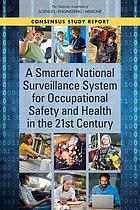 A Smarter National Surveillance System for Occupational Safety and Health in the 21st Century
by
The workplace is where 156 million working adults in the United States spend many waking hours, and it has a profound influence on health and well-being. Although some occupations and work-related activities are more hazardous than others and face higher rates of injuries, illness, disease, and fatalities, workers in all occupations face some form of work-related safety and health concerns. Understanding those risks to prevent injury, illness, or even fatal incidents is an important function of society. Occupational safety and health (OSH) surveillance provides the data and analyses needed to understand the relationships between work and injuries and illnesses in order to improve worker safety and health and prevent work-related injuries and illnesses. Information about the circumstances in which workers are injured or made ill on the job and how these patterns change over time is essential to develop effective prevention programs and target future research. The nation needs a robust OSH surveillance system to provide this critical information for informing policy development, guiding educational and regulatory activities, developing safer technologies, and enabling research and prevention strategies that serves and protects all workers. A Smarter National Surveillance System for Occupational Safety and Health in the 21st Century provides a comprehensive assessment of the state of OSH surveillance. This report is intended to be useful to federal and state agencies that have an interest in occupational safety and health, but may also be of interest broadly to employers, labor unions and other worker advocacy organizations, the workers' compensation insurance industry, as well as state epidemiologists, academic researchers, and the broader public health community. The recommendations address the strengths and weaknesses of the envisioned system relative to the status quo and both short- and long-term actions and strategies needed to bring about a progressive evolution of the current system.
A Smarter National Surveillance System for Occupational Safety and Health in the 21st Century
by
The workplace is where 156 million working adults in the United States spend many waking hours, and it has a profound influence on health and well-being. Although some occupations and work-related activities are more hazardous than others and face higher rates of injuries, illness, disease, and fatalities, workers in all occupations face some form of work-related safety and health concerns. Understanding those risks to prevent injury, illness, or even fatal incidents is an important function of society. Occupational safety and health (OSH) surveillance provides the data and analyses needed to understand the relationships between work and injuries and illnesses in order to improve worker safety and health and prevent work-related injuries and illnesses. Information about the circumstances in which workers are injured or made ill on the job and how these patterns change over time is essential to develop effective prevention programs and target future research. The nation needs a robust OSH surveillance system to provide this critical information for informing policy development, guiding educational and regulatory activities, developing safer technologies, and enabling research and prevention strategies that serves and protects all workers. A Smarter National Surveillance System for Occupational Safety and Health in the 21st Century provides a comprehensive assessment of the state of OSH surveillance. This report is intended to be useful to federal and state agencies that have an interest in occupational safety and health, but may also be of interest broadly to employers, labor unions and other worker advocacy organizations, the workers' compensation insurance industry, as well as state epidemiologists, academic researchers, and the broader public health community. The recommendations address the strengths and weaknesses of the envisioned system relative to the status quo and both short- and long-term actions and strategies needed to bring about a progressive evolution of the current system.


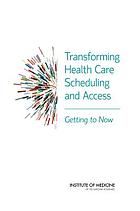 Transforming Health Care Scheduling and Access
by
According to "Transforming Health Care Scheduling and Access," long waits for treatment are a function of the disjointed manner in which most health systems have evolved to accommodate the needs and the desires of doctors and administrators, rather than those of patients. The result is a health care system that deploys its most valuable resource--highly trained personnel--inefficiently, leading to an unnecessary imbalance between the demand for appointments and the supply of open appointments. This study makes the case that by using the techniques of systems engineering, new approaches to management, and increased patient and family involvement, the current health care system can move forward to one with greater focus on the preferences of patients to provide convenient, efficient, and excellent health care without the need for costly investment. "Transforming Health Care Scheduling and Access" identifies best practices for making significant improvements in access and system-level change. This report makes recommendations for principles and practices to improve access by promoting efficient scheduling. This study will be a valuable resource for practitioners to progress toward a more patient-focused "How can we help you today?" culture.
Transforming Health Care Scheduling and Access
by
According to "Transforming Health Care Scheduling and Access," long waits for treatment are a function of the disjointed manner in which most health systems have evolved to accommodate the needs and the desires of doctors and administrators, rather than those of patients. The result is a health care system that deploys its most valuable resource--highly trained personnel--inefficiently, leading to an unnecessary imbalance between the demand for appointments and the supply of open appointments. This study makes the case that by using the techniques of systems engineering, new approaches to management, and increased patient and family involvement, the current health care system can move forward to one with greater focus on the preferences of patients to provide convenient, efficient, and excellent health care without the need for costly investment. "Transforming Health Care Scheduling and Access" identifies best practices for making significant improvements in access and system-level change. This report makes recommendations for principles and practices to improve access by promoting efficient scheduling. This study will be a valuable resource for practitioners to progress toward a more patient-focused "How can we help you today?" culture.




